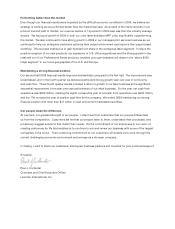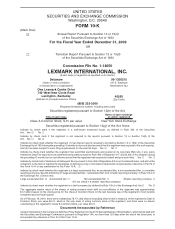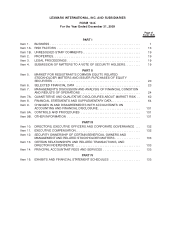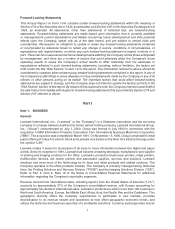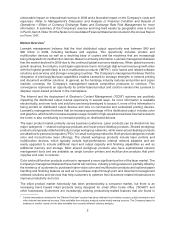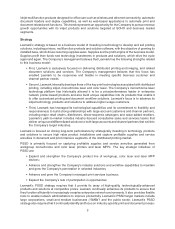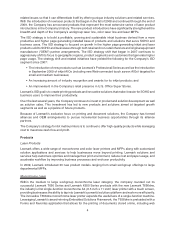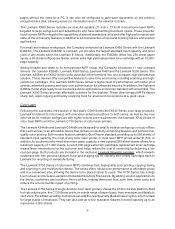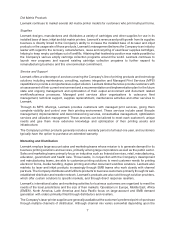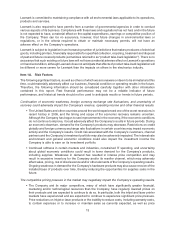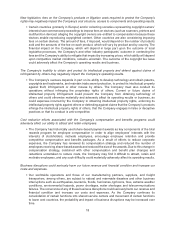Lexmark 2009 Annual Report Download - page 14
Download and view the complete annual report
Please find page 14 of the 2009 Lexmark annual report below. You can navigate through the pages in the report by either clicking on the pages listed below, or by using the keyword search tool below to find specific information within the annual report.geography, most of Lexmark’s laser supplies products sold commercially in 2009 were sold through the
Company’s network of Lexmark-authorized supplies distributors and resellers, who sell directly to end-
users or to independent office supply dealers.
Lexmark distributes its branded inkjet products and supplies through retail outlets as well as distributors
and resellers worldwide. Lexmark’s sales and marketing activities are organized to meet the needs of the
various geographies and the size of their markets. In North America, products are primarily distributed
through large discount store chains, consumer electronics stores, office superstores, wholesale clubs,
online, as well as through distributors. The Company’s EMEA, Latin American and Asia Pacific operations
distribute products through major distributors and information technology resellers and in selected
markets through key retailers.
Lexmark also sells its products through numerous alliances and OEM arrangements. During 2009, 2008
and 2007, one customer, Dell, accounted for $496 million or approximately 13%, $596 million or
approximately 13%, and $717 million or approximately 14% of the Company’s total revenue,
respectively. Sales to Dell are included in both PSSD and ISD.
Economic and Seasonal Trends
Lexmark’s business and results of operations have historically been affected by general economic
conditions. From time to time, the Company’s sales may be negatively affected by weak economic
conditions in those markets in which the Company sells its products. The recent economic recession
experienced by the United States and other countries around the world have adversely impacted the
Company’s sales and the severity and duration of these adverse economic conditions remains uncertain. If
current economic conditions persist or worsen, the Company’s sales could continue to be adversely
affected.
The Company experiences some seasonal market trends in the sale of its products and services. For
example, sales are often stronger during the second half of the year and sales in Europe are often weaker
in the summer months. The impact of these seasonal trends on Lexmark has become less predictable.
Competition
Lexmark continues to develop and market new products and innovative solutions at competitive prices.
New product announcements by the Company’s principal competitors, however, can have, and in the past,
have had, a material adverse effect on the Company’s financial results. Such new product announcements
can quickly undermine any technological competitive edge that one manufacturer may enjoy over another
and set new market standards for price, quality, speed and functionality. Furthermore, knowledge in the
marketplace about pending new product announcements by the Company’s competitors may also have a
material adverse effect on Lexmark as purchasers of printers may defer buying decisions until the
announcement and subsequent testing of such new products.
In recent years, Lexmark and its principal competitors, many of which have significantly greater financial,
marketing and/or technological resources than the Company, have regularly lowered prices on hardware
products and are expected to continue to do so. Lexmark has experienced and remains vulnerable to these
pricing pressures. The Company’s ability to grow or maintain market share has been and may continue to
be affected, resulting in lower profitability. Lexmark expects that as it competes with larger competitors, the
Company’s increased market presence may attract more frequent challenges, both legal and commercial,
including claims of possible intellectual property infringement.
The distributed printing market is extremely competitive. The distributed laser printing market is dominated
by Hewlett-Packard (“HP”), which has a widely-recognized brand name and has been identified as the
market leader as measured in annual units shipped. With the convergence of traditional printer and copier
markets, major laser competitors now include traditional copier companies such as Canon, Ricoh and
Xerox. Other laser competitors include Brother, Konica Minolta, Kyocera, Okidata and Samsung.
8


